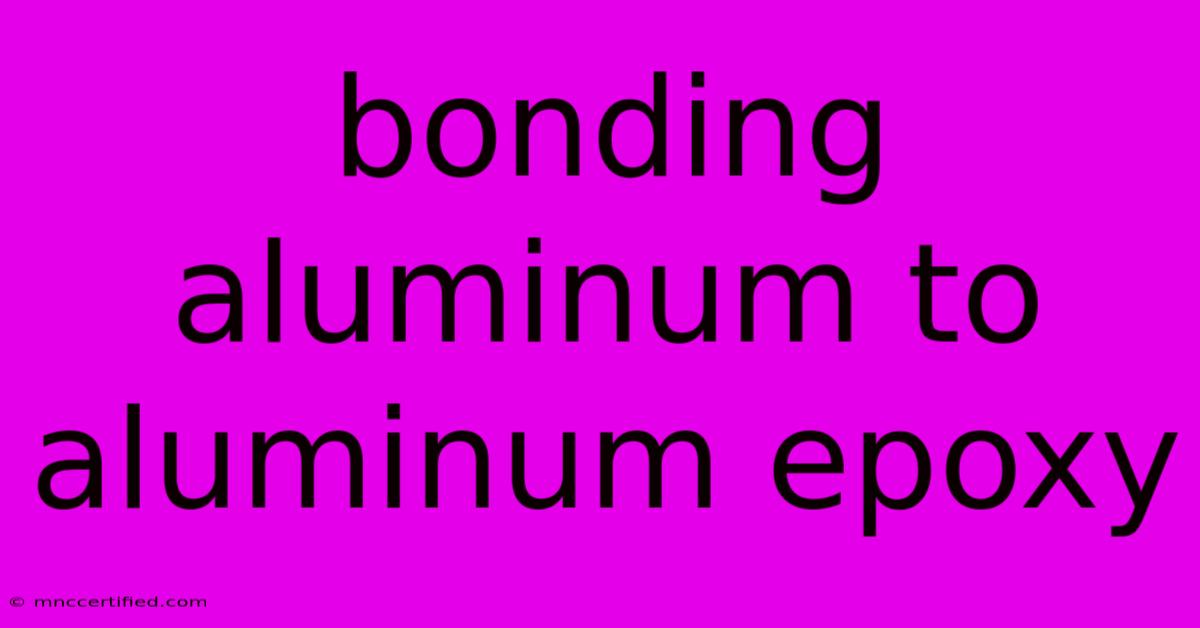Bonding Aluminum To Aluminum Epoxy

Table of Contents
Bonding Aluminum to Aluminum with Epoxy: A Comprehensive Guide
Bonding aluminum to aluminum requires a strong, reliable adhesive that can withstand various stresses. Epoxy is a popular choice, offering excellent adhesion, durability, and versatility. However, achieving a successful bond requires careful preparation and the right technique. This comprehensive guide will walk you through the process, ensuring your aluminum-to-aluminum bond is strong and long-lasting.
Why Choose Epoxy for Aluminum-to-Aluminum Bonding?
Epoxy adhesives are favored for aluminum-to-aluminum bonding due to several key advantages:
- High Strength: Epoxy resins form strong, durable bonds capable of withstanding significant stress and strain. This makes them suitable for a wide range of applications, from structural repairs to crafting.
- Versatility: Epoxies are available in various formulations, each designed for specific applications and substrates. You can find epoxies optimized for high temperature resistance, chemical resistance, or gap filling.
- Ease of Use: Many epoxy adhesives are relatively easy to apply, requiring minimal specialized tools or expertise.
- Cost-Effectiveness: Compared to other bonding methods, epoxy adhesives offer a cost-effective solution for many aluminum-to-aluminum bonding projects.
Choosing the Right Epoxy: Key Considerations
Selecting the appropriate epoxy is crucial for a successful bond. Consider these factors:
- Strength Requirements: Determine the strength needed for your application. High-strength epoxies are essential for load-bearing applications, while less demanding applications may require a standard-strength epoxy.
- Temperature Resistance: If the bonded aluminum will be exposed to high temperatures, choose a high-temperature epoxy.
- Chemical Resistance: If the bond will be exposed to chemicals, ensure the epoxy is compatible and resistant to those chemicals.
- Gap-Filling Properties: If there's a gap between the aluminum pieces, choose an epoxy with gap-filling capabilities to ensure complete contact and a strong bond. Aluminum epoxy gap fillers are specifically designed for this purpose.
Pro-Tip: Always refer to the manufacturer's instructions for specific application details and recommended cure times.
Step-by-Step Guide to Bonding Aluminum to Aluminum with Epoxy
-
Surface Preparation: This is the most critical step. Impure surfaces will result in weak bonds. Follow these steps meticulously:
- Cleaning: Thoroughly clean both aluminum surfaces with a suitable solvent like acetone or isopropyl alcohol to remove grease, oil, dirt, and other contaminants. Use a lint-free cloth or paper towel.
- Deburring: Remove any burrs, sharp edges, or imperfections from the surfaces. Use a file or sandpaper to achieve smooth, even surfaces.
- Abrasion: Lightly abrade the surfaces using fine-grit sandpaper (around 320-400 grit) to create a slightly rough surface, increasing the surface area for better adhesion. This step is vital for aluminum epoxy adhesion.
- Degreasing (Again!): After abrading, clean the surfaces again with solvent to remove any debris generated during the abrasion process.
-
Mixing the Epoxy: Carefully follow the manufacturer's instructions for mixing the resin and hardener. Inaccurate mixing ratios can significantly weaken the bond. Use a clean mixing stick or spatula and thoroughly mix until a uniform color is achieved.
-
Applying the Epoxy: Apply a thin, even layer of epoxy to one of the aluminum surfaces. Avoid applying excessive amounts, which can lead to air bubbles and a weaker bond.
-
Clamping and Curing: Carefully align the two aluminum surfaces and firmly clamp them together. Ensure even pressure across the entire bonding area. Allow the epoxy to cure completely according to the manufacturer's instructions. This usually involves a specific time frame and temperature. Improper curing leads to a weak bond.
-
Post-Cure Inspection: Once the epoxy has fully cured, inspect the bond for any imperfections. If any issues are present, consult the manufacturer's instructions or seek professional advice.
Troubleshooting Common Problems
- Weak Bond: This usually indicates insufficient surface preparation or improper mixing of the epoxy.
- Porous Bond: This could be due to air bubbles trapped during application.
- Bond Failure: This could be due to incorrect epoxy selection, inadequate curing, or excessive stress on the bond.
Remember that thorough surface preparation is key to a successful bond. Always prioritize cleanliness and proper mixing techniques when working with epoxy adhesives.
By following these steps and choosing the right epoxy, you can create a strong and reliable aluminum-to-aluminum bond for a wide range of applications. Investing time in proper preparation will ensure your project's success and longevity.

Thank you for visiting our website wich cover about Bonding Aluminum To Aluminum Epoxy. We hope the information provided has been useful to you. Feel free to contact us if you have any questions or need further assistance. See you next time and dont miss to bookmark.
Featured Posts
-
Watch Argentina Vs Paraguay Live Stream Info
Nov 15, 2024
-
Tate Mc Rae Show At Canadian Tire Centre
Nov 15, 2024
-
Homeowners Insurance No Inspection
Nov 15, 2024
-
Usmnt Wins First Leg Against Jamaica
Nov 15, 2024
-
Canada Non Resident Insurance Card
Nov 15, 2024